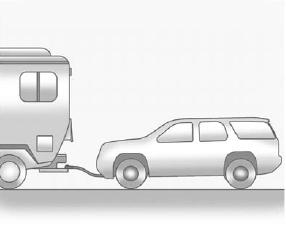Dinghy Towing

If the vehicle is front-wheel-drive, it can be dinghy towed from the front.
These vehicles may also be towed by putting the front wheels on a dolly. See “Dolly Towing” later in this section.
If the vehicle is all-wheel-drive, it can be dinghy towed from the front.
These vehicles can also be towed by placing them on a platform trailer with all four wheels off of the ground. These vehicles cannot be towed using a dolly.
For vehicles being dinghy towed, the vehicle should be run at the beginning of each day and at each RV fuel stop for about five minutes.
This will ensure proper lubrication of transmission components. Reinstall the fuse to start the vehicle.
To tow the vehicle from the front with all four wheels on the ground:
1. Position the vehicle to be towed, shift the transmission to P (Park), and turn the ignition to LOCK/OFF.
2. Secure the vehicle to the towing vehicle.
3. Set the parking brake.
4. Turn the ignition to ACC/ACCESSORY.
5. Shift the transmission to N (Neutral).
6. To prevent the battery from draining while the vehicle is being towed, remove the 20 amp ECM1 fuse and the 50 amp BATT1 fuse from the underhood fuse block and store in a safe location. See Engine Compartment Fuse Block on page 10‑31.
7. Release the parking brake.
Notice: If the vehicle is towed without performing each of the steps listed under “Dinghy Towing,” the automatic transmission could be damaged.
Be sure to follow all steps of the dinghy towing procedure prior to and after towing the vehicle.
Notice: If 105 km/h (65 mph) is exceeded while towing the vehicle, it could be damaged.
Never exceed 105 km/h (65 mph) while towing the vehicle.
Once the destination is reached:
1. Set the parking brake.
2. Reinstall the fuses in the underhood fuse block.
3. Shift the transmission to P (Park), turn the ignition to LOCK/OFF and remove the key from the ignition.
4. Disconnect the vehicle from the towing vehicle.
Notice: Do not tow a vehicle with the front drive wheels on the ground if one of the front tires is a compact spare tire. Towing with two different tire sizes on the front of the vehicle can cause severe damage to the transmission.
See also:
Towing the Vehicle
Notice: To avoid damage, the disabled vehicle should be towed with all four wheels
off the ground. Care must be taken with vehicles that have low ground clearance
and/or special equipment. Always ...
Making a Call
Calls can be made using the following commands.
Dial or Call: The dial or call command can be used interchangeably to dial a phone number or a stored name tag.
Digit Dial: This command allows a phon ...
Vehicle Security
This vehicle has theft-deterrent features; however, they do not make it impossible
to steal. ...





